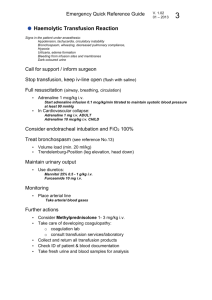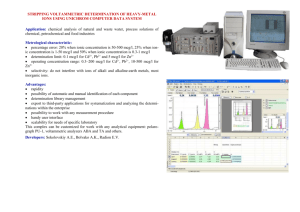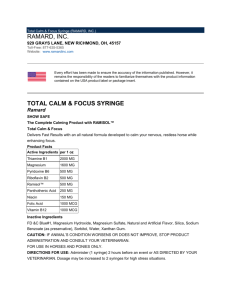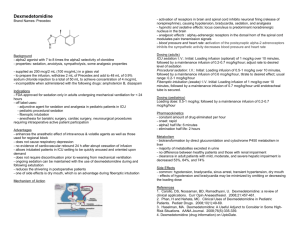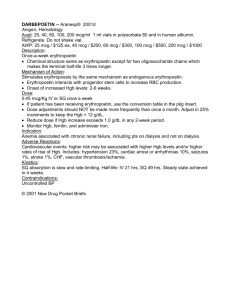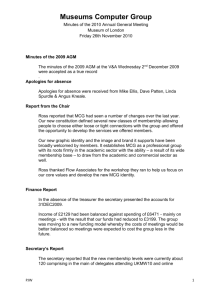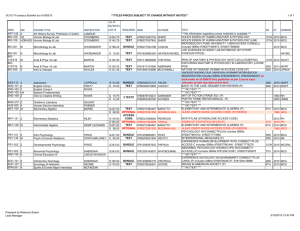Inotropes: ICU Self-Directed Learning for Nurses
advertisement
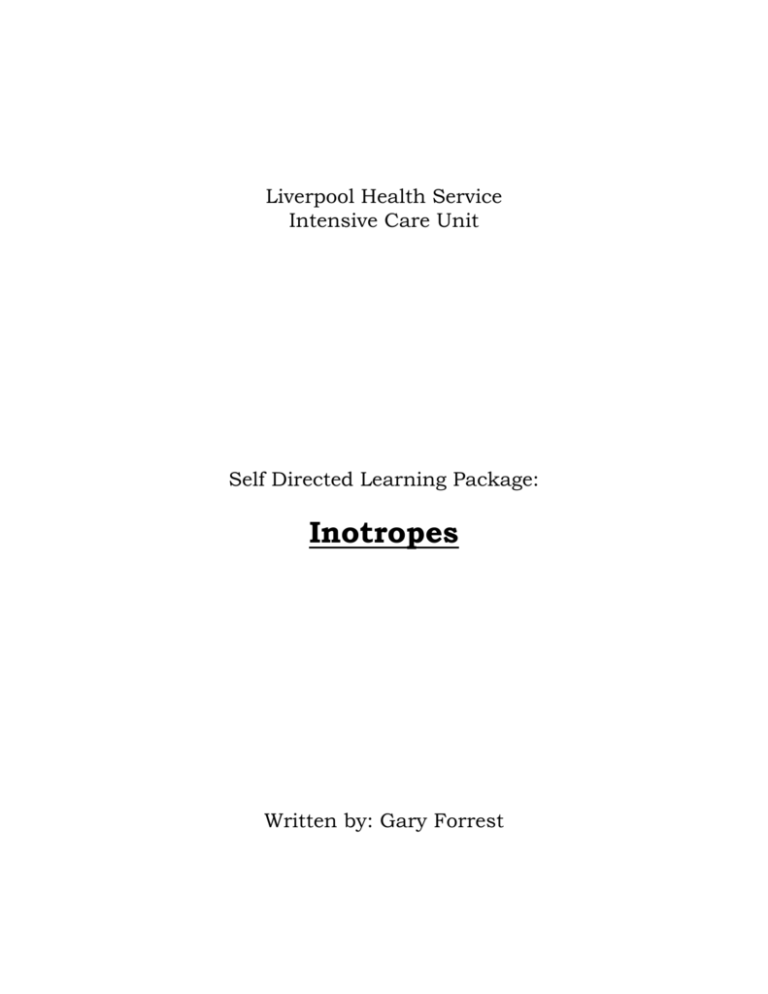
Liverpool Health Service Intensive Care Unit Self Directed Learning Package: Inotropes Written by: Gary Forrest How to use this package This package is designed to be used in the clinical area as a self directed learning tool. At the start of the package is a pre test which covers the information contained inside. You should read through the pretest and answer the questions. If you have any problems with any of the questions, this will provide you with some guidance as to the areas that you should focus on in the package. The package is divided into sections. At the end of each section is a self test to determine how well you have understood the information contained in that section. You will need to complete the self tests at the end of each section and ensure that you have mastered the content before moving on to the next section. If you have any trouble with the self test, go back over the section and revise the content. If you are still unsure then you will need to speak with one of the educators in your area. Once you have worked through the entire package, you should complete the post test. The answers to the post test are contained at the end of the package. If you have any trouble with the post test, go back to the section in the package and revise it. If you are still unsure, contact the educator in your area. GOOD LUCK!!! Learning package objectives By the completion of this package, the registered nurse will be able to: 1. Discuss the indications for the administration of inotropes in the Intensive Care Unit. 2. Define the relevant terminology used when discussing inotropic therapy. 3. Discuss the physiological effects elicited when the following receptor sites are stimulated: i. ii. iii. iv. Alpha Beta 1 Beta 2 Dopaminergic 4. Discuss the pharmacological effects and dosage ranges for the following inotropes: i. ii. iii. iv. Adrenaline Noradrenaline Dobutamine Dopamine 5. Discuss the complications and nursing care issues relevant to the administration of the above mentioned drugs. Pretest 1. Define shock. 2. List the three factors that need to occur for tissues to be oxygenated 3. What effect do inotropes have on myocardial rate and contractility? 4. Complete the following haemodynamic equations: • Cardiac output = ? x ? • Mean arterial pressure = ? x ? x? 5. Define: • • • • • • 6. Cardiac output Preload Afterload Stroke volume Inotropy Chronotropy Discuss the response elicited when the following receptors are activated: • • • • Alpha Beta 1 Beta 2 Dopaminergic 7. Perform the following drug calculations: You have a 50 ml syringe with 16 mg of noradrenaline running at 8 ml/hr. The patient weighs 80 kg. What dose (in mcg/kg/min) is the patient receiving? You are asked to commence an adrenaline infusion at 0.02 mcg/kg/min. Your unit policy requires the adrenaline be made up as 4mg in 50 ml and administered via a syringe pump. The patient weighs 75 kg. What rate (in ml/hr) would you commence the infusion? 8. Outline the receptors activated by the following inotropes: • • • • • • • Adrenaline running at < 0.02 mcg/kg/min Adrenaline running at > 0.02 mcg/kg/min Noradrenaline running at 0.3 mcg/kg/min Dobutamine running at 8 mcg/kg/min Dopamine running at < 2 mcg/kg/min Dopamine running at 2 – 10 mcg/kg/min Dopamine running at > 10 mcg/kg/min 9. Discuss the effects of tachycardia on myocardial oxygen demands. 10. Discuss the effects of increased afterload on myocardial oxygen demands. 11. Discuss the effects of tachycardia on stroke volume and cardiac output. 12. Explain why dobutamine may be a useful inotrope following a myocardial infarction. 13. Explain why noradrenaline may be a useful inotrope in septic shock. 14. What is the unit policy on purging inotropes? Introduction Inotropes are powerful drugs that are used in Intensive Care to regulate a patient’s heart rate, blood pressure and the force of contraction of the heart. They do this by working on specific receptors throughout the body. Because of their strength, they are able to exert their effects at very low doses. Increasing this dosage can activate other receptors and result in undesired effects which may be detrimental to the patient. It is imperative that nurses caring for patients who are receiving inotropes are aware of the specific dosage ranges and the receptors activated, the desired effects of the drugs and the complications associated with their administration. This self directed learning package is designed to assist registered nurses caring for patients receiving inotropes. It can be completed at the bedside and will assist with the safe and effective administration of inotropic agents. Indications for inotropes Inotropes may be needed when a patient is in shock. Shock is generally associated with a low blood pressure but the definition of shock is much more than that. Shock is defined as “inadequate tissue oxygenation”. To explain this further, you can have a normal blood pressure and not have the tissues being oxygenated so this would be defined as shock. Alternatively you can have a low blood pressure and still have the tissues being oxygenated so this wouldn’t be defined as shock. Inotropes and tissue oxygenation For tissues to be oxygenated, 3 factors need to be considered: 1) Oxygen transfer across the alveolar-capillary membrane 2) Oxygen attachment to haemaglobin 3) Adequate cardiac output (CO) to move the oxyhaemaglobin molecule to the tissues In relation to this last point, there are several ways of increasing CO: 1) Enhancing circulating volume through fluid resuscitation (increasing preload) 2) Enhancing myocardial contractility with inotropes (their inotropic effect) 3) Manipulating heart rate with inotropes (their chronotropic effect) You can see how inotropes are useful in the management of shock and tissue oxygenation. Haemodynamic equations Inotropes are used in shock mainly to manipulate cardiac output and afterload (systemic vascular resistance (SVR)). In order to understand this, consider the following simplified haemodynamic model: Cardiac output (CO) = Heart Rate (HR) x Stroke Volume (SV) Where SV is the volume of blood ejected by the left ventricle (approximately 70ml) Normal CO = 4 to 8 Litres/minute Generally we measure Blood Pressure (BP) not CO so how do these relate? Mean Arterial Pressure (MAP) = CO x SVR (afterload) Therefore: MAP = SV x HR x SVR Can you see how inotropes may be useful? Before you go any further, try the following self test. Self test 1. 1. Define shock. 2. List the three factors that need to occur for tissues to be oxygenated 3. What effect do inotropes have on myocardial rate and contractility? 5. Complete the following haemodynamic equations: • Cardiac output = ? x ? • Mean arterial pressure = ? x ? x? Haemodynamic terminology Before we move on it might be useful to revise some definitions. • Cardiac output The amount of blood ejected from the left ventricle during systole over a period of one minute. Cardiac output is determined by multiplying heart rate by stroke volume • Preload The volume of blood in the ventricle at the end of diastole • Afterload The resistance that the heart must pump against in order to eject the blood. This resistance is provided by the arterial system • Stroke volume The amount of blood ejected by the left ventricle • Inotropy Increased strength of contraction • Chronotropy Increased rate of contraction Receptor activation Inotropes work by targeting specific receptor sites in the body. The degree of effect depends upon the dose of the inotrope and the receptor it targets. The following table summarises the receptor type and the effect seen. Receptor Type Effect Alpha Vasoconstriction Beta 1 Increased heart rate and contractility Bronchodilation; vasodilation of skeletal and coronary blood vessels Vasodilation of renal and mesenteric blood vessels Beta 2 Dopaminergic Calculating drug dosages When choosing an inotrope to treat shock, the haemodynamic values can be manipulated by selecting a drug and dose that affects the receptor type. As the receptor activation is dependent on the dose of the drug given, it is necessary to be able to calculate drug dosages in micrograms per kilogram per minute (mcg/kg/min). The following discussion will show you how this is done. To calculate mcg/kg/min for a given infusion rate: mcg/kg/min = rate (ml/hr) x concentration (mcg/ml) divide by weight (kg) divide by 60 For example: A patient is receiving an adrenaline infusion at 5 ml/hr. The infusion is 4 mg in 50 ml (80mcg/ml). The patient weighs 90 kg. You need to calculate the dose that the patient is receiving in mcg/kg/min. mcg/kg/min = 5 x 80 divide by 90 divide by 60 = 0.07 mcg/kg/min To calculate infusion rate for a specific dose ml/hr = dose (mcg/kg/min) x patient’s weight (kg) x 60 x volume (ml) divide by (strength (mg) x 1000) For example: You want to give a patient who weighs 75 kg a dose of 5 mcg/kg/min of dobutamine. The bag of 500 ml of 5% dextrose contains 250 mg of dobutamine. You need to calculate the rate of the infusion ml/hr = (5 x 75 x 60 x 500) divide by (1000 x 250) = 45 ml/hr Before you go any further, try the following self test. Self test 2. 1. Define: • • • • • • Cardiac output Preload Afterload Stroke volume Inotropy Chronotropy 2. Discuss the response elicited when the following receptors are activated: • Alpha • Beta 1 • Beta 2 • Dopaminergic 3. Perform the following drug calculations: You have a 50 ml syringe with 16 mg of noradrenaline running at 8 ml/hr. The patient weighs 80 kg. What dose (in mcg/kg/min) is the patient receiving? You are asked to commence an adrenaline infusion at 0.02 mcg/kg/min. Your unit policy requires the adrenaline be made up as 4mg in 50 ml and administered via a syringe pump. The patient weighs 75 kg. What rate (in ml/hr) would you commence the infusion? In the next part of our discussion we will look at some common inotropic drugs and dosage ranges. Pharmacology There are four inotropes that we will be considering in this package: • • • • Adrenaline Noradrenaline Dobutamine Dopamine Adrenaline • Also known as epinephrine in the North American literature • Works on alpha, beta 1 and beta 2 receptors • The net result is increased HR, BP and CO Low doses • < 0.02 mcg/kg/min • primarily beta 1 and beta 2 but beta 1 more dominant • increases heart rate (chronotropy) • increases force of contraction (inotropy) • increases cardiac output • dilates bronchi • dilates skeletal muscle and coronary blood vessels High doses • > 0.02 mcg/kg/min • mainly alpha effects • increases blood pressure and SVR secondary to vasoconstriction Clinical application You are managing a patient on an adrenaline infusion. You calculate the dose at 0.01 mcg/kg/min. Your clinical assessment reveals: • HR 110/minute • BP 110/60 • Warm peripheries (beta 1 effects) (beta 1 effects) (beta 2 effects) Points for consideration A tachycardia will increase the amount of workload and myocardial oxygen requirement of the heart. In patients who have cardiac disease, the myocardial oxygen demands may exceed the myocardial oxygen supply and myocardial ischaemia may result. Clinical application The dose of the adrenaline infusion in the first case scenario is increased to 0.03 mcg/kg/min. Your clinical assessment now reveals: • HR 150/minute • BP 100/60 • Cool peripheries (beta 1 effects) (alpha effects) Points for consideration Increasing the dosage has resulted in increased beta 1 effects (tachycardia) and some alpha effects causing vasoconstriction and cool peripheries. This should increase the BP but hasn’t. A possible reason for this is the tachycardia is not allowing the ventricles time to fill adequately hence less blood is ejected from the left ventricle (decreased stroke volume). You can see how important it is to monitor your patient closely and understand the desired effects and problems associated with these medications. Noradrenaline • Also known as norepinephrine in the North American literature • Works on alpha and beta receptors • The net result is increased CO, SVR and MAP Low doses • beta 1 effects predominate High doses • alpha effects predominate Dosage range • 0.05 mcg/kg/min to more than 0.3 mcg/kg/min Clinical application A patient is started on a noradrenaline infusion at 0.05 mcg/kg/min. You are asked to titrate the noradrenaline to keep the MAP greater than 70 mmHg. You periodically increase the infusion and stop when the MAP has stabilised at 70 mmHg. Your clinical assessment reveals: • HR 90/minute • BP 108/52 MAP (71) • Cool peripheries (alpha effects) (alpha effects) Points for consideration As the alpha effects dominate and vasoconstriction occurs, SVR or afterload increases. This means the heart will have to work a lot harder in order to eject the blood from the ventricle. Increased heart workload means increased myocardial oxygen demands. If this exceeds myocardial oxygen supply, then ischaemia may occur. This could have a significant impact on patients with a cardiac history. Dobutamine • Works on beta 1 and beta 2 receptors • The net effects are increased CO and minimally increased HR • Decreased SVR and MAP As dobutamine works primarily on beta 1 receptors, it increases the force of myocardial contraction (inotropy) without significant increases in heart rate (chronotropy). Mild beta 2 stimulation results in slight vasodilation which can decrease SVR and MAP. Dosage range • 2 – 15 mcg/kg/min Clinical application A patient with a myocardial infarction is hypotensive. A decision is made to commence a dobutamine infusion at 8 mcg/kg/min. Your clinical assessment reveals: • HR • BP 84/minute 110/50 Points for consideration Dobutamine is often a good drug to use in myocardial infarction as it doesn’t increase HR (beta 1) and myocardial oxygen demands or increase SVR (alpha effects) and myocardial workload. As it does not have any alpha properties, BP is supported by increased myocardial contractility only, therefore if hypotension persists an alpha stimulant may be required. Dopamine • Works on dopaminergic, alpha, beta 1 and beta 2 receptors • The effects are dose dependent • Can work to increase renal blood flow, CO, HR and SVR Dopamine is dose dependent as follows: Low doses • 0.05 – 2 mcg/kg/min • dopaminergic receptors • increased renal and mesenteric blood flow Moderate doses • 2 – 10 mcg/kg/min • beta 1 receptors • increased HR and contractility High doses • • • • > 10 mcg/kg/min alpha receptors increased SVR dopaminergic effects lost Clinical application A patient has a low urine output despite fluid challenges and a normal blood pressure. A decision is made to commence low dose dopamine at 2 mcg/kg/min. Points for consideration There is much debate about the usefulness of low dose dopamine for improving urine output and there have been several research papers which have questioned its value. For this reason, widespread use of dopamine at this dosage range is uncommon. Some final points for consideration…. Purging inotropes. As a general rule, inotropes should never be purged. Purging results in uneven doses of the inotrope being given to the patient and as a result the patient can have huge changes in their haemodynamic parameters. Inotropes need to be regulated by continuous infusion to maintain a consistent dose delivery and haemodynamic control. The unit protocol states that inotropes should never be purged. Changing a syringe. Preparing the next syringe should never be left until the last minute. Inotrope infusions should never run out. Some patients are very dependent on their inotropes and will not tolerate them being turned off for even a short period of time. It is compulsory to have the next infusion prepared as soon as the current syringe is connected (have a replacement syringe prepared regardless of strength & rate of infusion). Some patients may become haemodynamically unstable for the short time that the syringe is being changed. There are two ways to overcome this. One way is to start the second infusion through a three way tap while the first is still running. When the blood pressure starts to rise, cease the first infusion immediately. For this method, a three way tap should be connected into the line when the inotrope is first started. If you are starting an inotrope, it is good practice to include a three way tap to facilitate syringe changes. The second way is to change the syringe quickly and observe for any changes in your patient’s blood pressure. If the blood pressure drops, increase the infusion rate regularly until the blood pressure starts to climb. Wean the rate slowly back to the original rate keeping the blood pressure stable. It is always a good idea to get some help when you are changing a syringe until you become comfortable with regulating inotropes. Choosing a lumen. Inotropes should always be infused through a separate lumen to avoid purges of the drug should fluid challenges be given. For this reason, the proximal lumen is chosen Remember, when in doubt – ASK! Before you go any further, try the following self test. Self test 3. 1. Outline the receptors activated by the following inotropes: • • • • • • • Adrenaline running at < 0.02 mcg/kg/min Adrenaline running at > 0.02 mcg/kg/min Noradrenaline running at 0.3 mcg/kg/min Dobutamine running at 8 mcg/kg/min Dopamine running at < 2 mcg/kg/min Dopamine running at 2 – 10 mcg/kg/min Dopamine running at > 10 mcg/kg/min 2. Discuss the effects of tachycardia on myocardial oxygen demands. 3. Discuss the effects of increased afterload on myocardial oxygen demands. 4. Discuss the effects of tachycardia on stroke volume and cardiac output. 5. Explain why dobutamine may be a useful inotrope following a myocardial infarction. 6. Explain why noradrenaline may be a useful inotrope in septic shock. 7. What is the unit policy on purging inotropes and on syringe preparation? Post test 1. Define shock. 2. List the three factors that need to occur for tissues to be oxygenated 3. What effect do inotropes have on myocardial rate and contractility? 4. Complete the following haemodynamic equations: • Cardiac output = ? x ? • Mean arterial pressure = ? x ? x? 5. Define: • • • • • • 6. Cardiac output Preload Afterload Stroke volume Inotropy Chronotropy Discuss the response elicited when the following receptors are activated: • • • • Alpha Beta 1 Beta 2 Dopaminergic 7. Perform the following drug calculations: You have a 50 ml syringe with 16 mg of noradrenaline running at 8 ml/hr. The patient weighs 80 kg. What dose (in mcg/kg/min) is the patient receiving? You are asked to commence an adrenaline infusion at 0.02 mcg/kg/min. Your unit policy requires the adrenaline be made up as 4mg in 50 ml and administered via a syringe pump. The patient weighs 75 kg. What rate (in ml/hr) would you commence the infusion? 8. Outline the receptors activated by the following inotropes: • • • • • • • Adrenaline running at < 0.02 mcg/kg/min Adrenaline running at > 0.02 mcg/kg/min Noradrenaline running at 0.3 mcg/kg/min Dobutamine running at 8 mcg/kg/min Dopamine running at < 2 mcg/kg/min Dopamine running at 2 – 10 mcg/kg/min Dopamine running at > 10 mcg/kg/min 9. Discuss the effects of tachycardia on myocardial oxygen demands. 10. Discuss the effects of increased afterload on myocardial oxygen demands. 11. Discuss the effects of tachycardia on stroke volume and cardiac output. 12. Explain why dobutamine may be a useful inotrope following a myocardial infarction. 13. Explain why noradrenaline may be a useful inotrope in septic shock. 14. What is the unit policy on purging inotropes? 15. What is the unit [policy on syringe preparation? 16. Answers to the Post test 1. Shock is defined as “inadequate tissue oxygenation”. 2. i) Oxygen transfer across the alveolar-capillary membrane ii) Oxygen attachment to haemaglobin iii) Adequate cardiac output (CO) to move the oxyhaemaglobin molecule to the tissues 3. Inotropes increase myocardial rate and contractility. 4. Cardiac output - The amount of blood ejected from the left ventricle during systole over a period of one minute. Cardiac output is determined by multiplying heart rate by stroke volume Preload - The volume of blood in the ventricle at the end of diastole Afterload - The resistance that the heart must pump against in order to eject the blood. This resistance is provided by the arterial system Stroke volume - The amount of blood ejected by the left ventricle Inotropy - Increased strength of contraction Chronotropy - Increased rate of contraction 5. Cardiac output = heart rate x stroke volume Mean arterial pressure = heart rate x stroke volume x systemic vascular resistance 6. Alpha – vasoconstriction. Increased blood pressure and cool peripheries Beta 1 – increased heart rate Beta 2 – bronchodilation and vasodilation of skeletal and coronary blood vessels Dopaminergic – increased renal and mesenteric blood flow 7. 0.53 mcg/kg/min 1.1 ml/hr 8. Adrenaline running at < 0.02 mcg/kg/min – beta Adrenaline running at > 0.02 mcg/kg/min - alpha Noradrenaline running at 0.3 mcg/kg/min – alpha Dobutamine running at 8 mcg/kg/min - beta Dopamine running at < 2 mcg/kg/min dopaminergic Dopamine running at 2 – 10 mcg/kg/min - beta Dopamine running at > 10 mcg/kg/min - alpha 9. Tachycardia will increase myocardial oxygen demands. This can be detrimental if myocardial oxygen demands exceed myocardial oxygen supply. 10. Increased afterload will increase myocardial oxygen demands. As the heart has to work harder to pump the blood out against constricted vessels, its workload increases as does its myocardial oxygen demands. 11. Tachycardia may result in a decreased stroke volume and cardiac output. As the heart beats faster it may not have enough time to fill during diastole. This will result in a decreased stroke volume. As cardiac output is dependent on stroke volume, this may decrease also. 12. Dobutamine may be a useful inotrope following a myocardial infarction as it has beta effects only. The beta effects will increase the force of contraction without increasing heart rate and myocardial oxygen demands. As dobutamine has no alpha properties, afterload is not increased hence myocardial workload and oxygen demands are not increased. 13. Noradrenaline may be a useful inotrope in septic shock as its alpha effects will increase afterload and assist with raising systemic blood pressure. 14. Inotropes should never be purged. 15. The replacement inotrope syringe should be prepared as soon as the current syringe is connected. There MUST always be a replacement syringe prepared in the bed area regardless of strength and rate of infusion.
